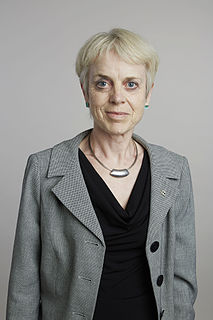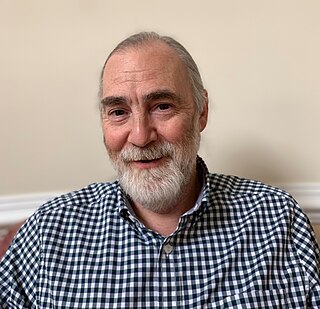Related Research Articles

Fellowship of the Royal Society is an award granted to individuals that the Royal Society of London judges to have made a 'substantial contribution to the improvement of natural knowledge, including mathematics, engineering science, and medical science'.
Sir (Paul) Patrick (Gordon) Bateson, was an English biologist with interests in ethology and phenotypic plasticity. Bateson was a Professor at the University of Cambridge and served as president of the Zoological Society of London from 2004 to 2014.

Jonathan Felix Ashmore is a British physicist and Bernard Katz Professor of Biophysics at University College London.

Alfred William (Bill) Rutherford FRS is Professor and Chair in Biochemistry of Solar energy in the Department of Life sciences at Imperial College London.

Annette Catherine Dolphin is a Professor of Pharmacology in the Department of Neuroscience, Physiology and Pharmacology at University College London (UCL).

Neil Burgess is a Professor of Cognitive neuroscience at University College London and a Wellcome Trust Principal Research Fellow. He has made important contributions to understanding memory and spatial cognition by developing computational models relating behaviour to activity in biological neural networks.

Tracy Palmer is a Professor of Microbiology in the Centre for Bacterial Cell Biology at Newcastle University in Tyne & Wear, England. She is known for her work on the twin-arginine translocation (Tat) pathway.

Andrew John King is a Professor of Neurophysiology and Wellcome Trust Principal Research Fellow in the Department of Physiology, Anatomy and Genetics at the University of Oxford and a Fellow of Merton College, Oxford.

Dominic Kwiatkowski is head of the parasites and microbes programme at the Wellcome Sanger Institute in Cambridge and a Professor of Genomics at the University of Oxford. Kwiatkowski applies genomics and computational analysis to problems in infectious disease, with the aim of finding ways to reduce the burden of disease in the developing world.
Gurdyal Singh Besra is Bardrick Professor of Microbial Physiology & Chemistry at the University of Birmingham.
Leonid A. Sazanov is a Professor at the Institute of Science and Technology Austria (IST). Sazanov research explores the structure and function of large membrane protein complexes from the domain of bioenergetics. These molecular machines interconvert redox energy and proton motive force across biological membranes using a variety of mechanisms.
Anant B. Parekh is Professor of Physiology at the University of Oxford and a Fellow of Merton College, Oxford.
John-Michael Kendall is a Geophysicist and Professor in the Department of Earth Sciences at the University of Oxford.
(Thomas) Martin Embley is a Professor at Newcastle University who has made contributions to our understanding of the origin of eukaryotes and the evolution of organelles such as mitochondria, mitosomes and hydrogenosomes, that are found in parasitic protists.
Ian Tomlinson is a director of the Institute of Cancer and Genomic Sciences at the University of Birmingham.
John Marius Rodenburg is Professor in the Department of Electronic and Electrical Engineering at the University of Sheffield.

Mark Lee Mayer is scientist emeritus at the National Institutes of Health (NIH). His research investigates glutamate receptor ion channels, the major mediators of excitatory synapses in the brain. He has made numerous observations that have changed our view of receptor function and neurotransmission in the brain. Major findings include discovery of the block of NMDA receptors by extracellular Mg and their high Ca permeability; analysis of the permeation and block of Ca permeable AMPA and kainate receptors by cytoplasmic polyamines; and structural studies on ligand binding, allosteric modulation, and gating using X-ray diffraction and cryoelectron microscopy.
Richard M. Harland is CH Li Distinguished Professor of Genetics, Genomics and Development at the University of California, Berkeley.
Gregory D. Scholes is William S. Tod Professor of Chemistry at Princeton University.
Andrew Dawson Taylor is director of the Science and Technology Facilities Council (STFC) National Laboratories – Rutherford Appleton Laboratory (RAL), Daresbury Laboratory, and the UK Astronomy Technology Centre (UKATC) in Edinburgh.
References
- ↑ "The Department of Physiology and Biophysics - School of Medicine - Case Western Reserve University". physiology.case.edu.
- ↑ Nicholls, D G; Locke, R M (1984). "Thermogenic mechanisms in brown fat". Physiological Reviews. 64 (1): 1–64. doi:10.1152/physrev.1984.64.1.1. ISSN 0031-9333. PMID 6320232.
- ↑ David G. Nicholls publications indexed by Google Scholar

- 1 2 3 Anon (2019). "Professor David Nicholls FRS". royalsociety.org. London: Royal Society. Archived from the original on 2019-04-24. One or more of the preceding sentences incorporates text from the royalsociety.org website where:
“All text published under the heading 'Biography' on Fellow profile pages is available under Creative Commons Attribution 4.0 International License.” --Royal Society Terms, conditions and policies at the Wayback Machine (archived 2016-11-11)
- ↑ Nicholls, David G. (2008). "Forty years of Mitchell's proton circuit: From little grey books to little grey cells". Biochimica et Biophysica Acta (BBA) - Bioenergetics. 1777 (7–8): 550–556. doi:10.1016/j.bbabio.2008.03.014. ISSN 0005-2728. PMC 2475803 . PMID 18423395.
- ↑ Nicholls, David G.; Ferguson, Stuart J. (2013). Bioenergetics (Fourth ed.). Amsterdam. ISBN 9780123884312. OCLC 846495013.
- ↑ Anon (2015). "Royal Society Elections". London: Royal Society. Archived from the original on 2015-09-06.